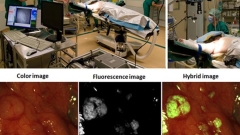Clinical translation of Fluorescence Molecular Imaging

Figure: Phil. Trans. R. Soc. A 369(1955), 4666-4678 (2011). doi:10.1098/rsta.2011.0270. (top right) and Nature Medicine 17(10): 1315-1319 (2011). doi:10.1038/nm.2472. (bottom)
We translate novel molecular imaging methods for clinical interventional imaging, which is expected to shift the paradigm of disease detection within surgical and endoscopic procedures. The work seen in Fig.1 shows our fluorescence camera installed in the operating room (collaboration with Prof. Van Dam UMCG) and results from an ovarian cancer patient. The results show the integration of novel imaging modalities with the clinical translation of a fluorescent agent with targeting specificity to the folate receptor alpha; upregulated in ovarian cancer. This study (Nat. Med. 2011 17:1315-9) showed the first human use of targeted fluorescent dye in humans. Imaging is accomplished through a camera system that can detect and resolve color and NIR fluorescence in real-time. Translation of more agents is expected over the next years to address a larger number of diseases. In Science Translational Medicine we also described the challenges associated with the clinical translation of fluorescent agents and provided an overview of alternatives to confront these challenges and reduce the risk and investment required for interventional use. For further details see Scheuer et. al. Sci. Transl. Med. 2012 4:134ps11.